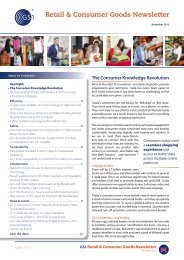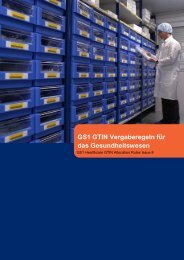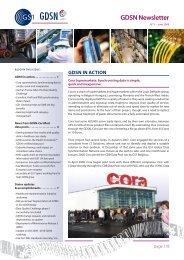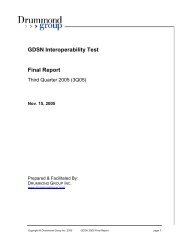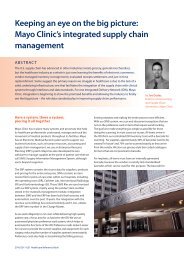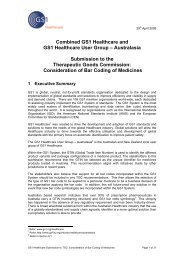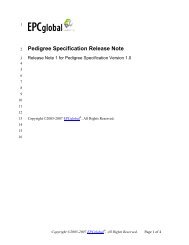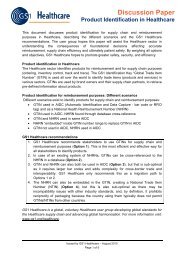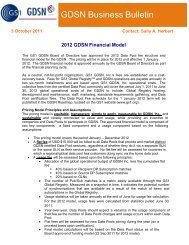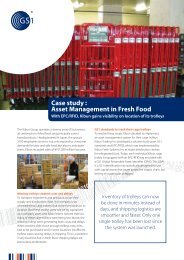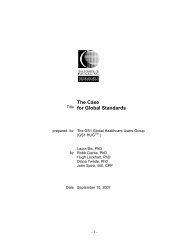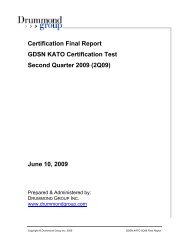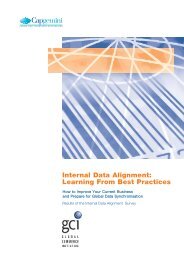The Application Level Events (ALE) Specification, Version 1.0 - GS1
The Application Level Events (ALE) Specification, Version 1.0 - GS1
The Application Level Events (ALE) Specification, Version 1.0 - GS1
Create successful ePaper yourself
Turn your PDF publications into a flip-book with our unique Google optimized e-Paper software.
1151<br />
1152<br />
1153<br />
1154<br />
1155<br />
1156<br />
1157<br />
1158<br />
1159<br />
1160<br />
1161<br />
1162<br />
1163<br />
1164<br />
1165<br />
1166<br />
1167<br />
1168<br />
1169<br />
1170<br />
1171<br />
1172<br />
1173<br />
1174<br />
1175<br />
1176<br />
1177<br />
1178<br />
1179<br />
1180<br />
1181<br />
1182<br />
1183<br />
1184<br />
1185<br />
1186<br />
1187<br />
1188<br />
<strong>The</strong> syntax for FILE notification URIs as used by <strong>ALE</strong> is defined in [RFC1738],<br />
Section 3.10. Informally, an FILE URI has one of the two following forms:<br />
file://host/path<br />
file:///path<br />
where<br />
• host is the DNS name or IP address of a remote host whose filesystem is accessible<br />
to the <strong>ALE</strong> implementation.<br />
• path is the pathname of a file within the remote filesystem, or the local filesystem if<br />
host is omitted.<br />
<strong>The</strong> <strong>ALE</strong> implementation delivers an event cycle report by appending to the specified file<br />
the ECReports instance encoded in XML according to the schema specified in<br />
Section 10.2. Note that if more than one event cycle completes, the file will contain a<br />
concatenation of XML documents, rather than a single XML document.<br />
Implementations of <strong>ALE</strong> may impose additional constraints on the use of the FILE URI.<br />
For example, some implementations of <strong>ALE</strong> may support only a local filesystem while<br />
others may support only a remote filesystem, some implementations of <strong>ALE</strong> may impose<br />
further restrictions on the syntax of the path component, and so forth. This<br />
specification also does not define the behavior when path names a directory; the<br />
behavior in that case is implementation dependent.<br />
Rationale (non-normative): <strong>The</strong> intended use for the FILE notification URI is for<br />
debugging, and hence the specification is intentionally lax in order to give freedom to<br />
implementations to provide the most appropriate and useful facility given the unique<br />
circumstances of that implementation.<br />
10 XML Schema for Event Cycle Specs and Reports<br />
This section defines the standard XML representation for ECSpec instances<br />
(Section 8.2) and ECReports instances (Section 8.3), using the W3C XML Schema<br />
language [XSD1, XSD2]. Samples are also shown.<br />
<strong>The</strong> schema below conforms to EPCglobal standard schema design rules. <strong>The</strong> schema<br />
below imports the EPCglobal standard base schema, as mandated by the design rules.<br />
10.1 Extensibility Mechanism<br />
<strong>The</strong> XML schema in this section implements the given in<br />
the UML of Section 8 using a methodology described in [XML<strong>Version</strong>ing]. This<br />
methodology provides for both vendor extension, and for extension by EPCglobal in<br />
future versions of this specification or in supplemental specifications. Extensions<br />
introduced through this mechanism will be backward compatible, in that documents<br />
conforming to older versions of the schema will also conform to newer versions of the<br />
standard schema and to schema containing vendor-specific extensions. Extensions will<br />
also be forward compatible, in that documents that contain vendor extensions or that<br />
Copyright © 2005, 2004 EPCglobal Inc, All Rights Reserved. Page 39 of 71



